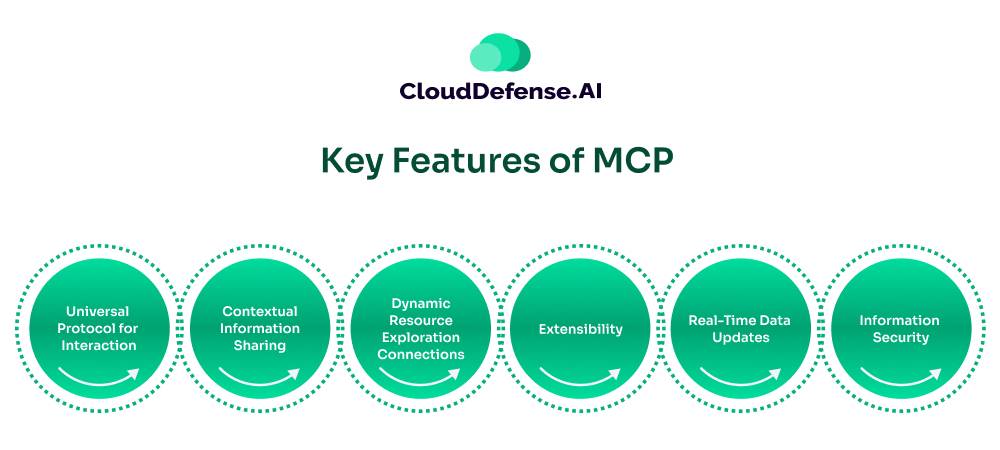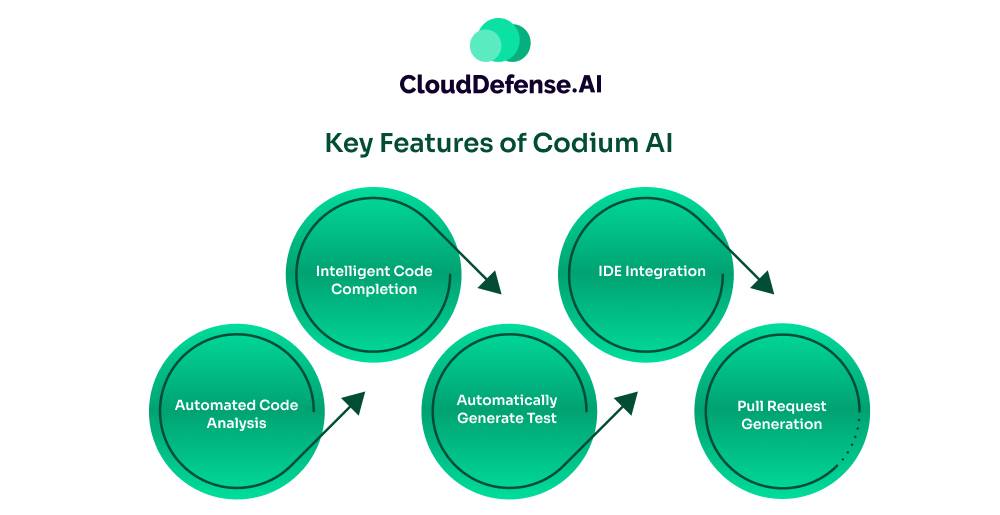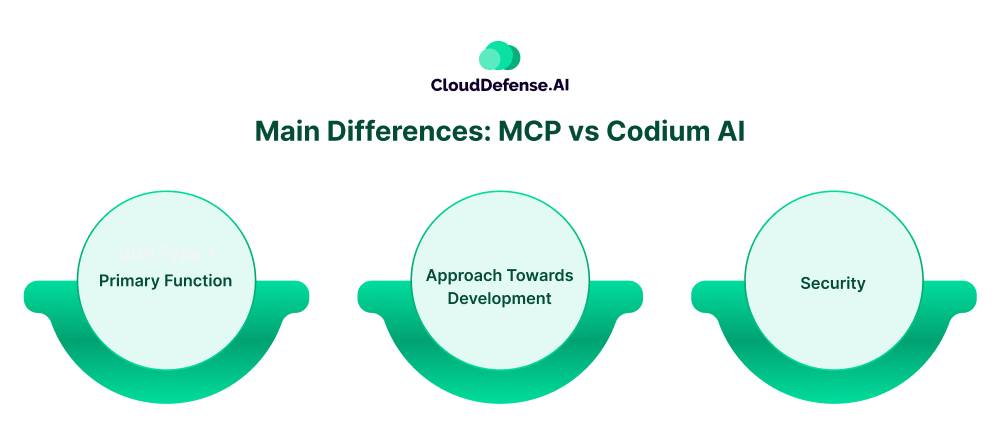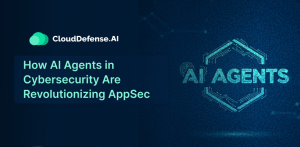MCP (Model Context Protocol) and Codium AI serve as two important aspects of the modern AI based software development process. AI tools like Codium AI (currently Qodo) are already revolutionizing how developers write and debug code. MCP on the other hand, is streamlining AI assisted coding and enabling seamless connectivity of AI coding assistants to outside resources.
This approach provides a standard control plane for AI agents to coordinate and connect to external resources. While these approaches simplify the AI based web development process, they differ in purpose and working. We take a look at the detailed comparison of MCP vs Codium AI and understand their roles along with their differences.
MCP: Control Plane Coordination
Model Context Protocol or MCP is an open protocol designed by Anthropic. It provides a pre-configured control platform that facilitates AI agents to coordinate and interact with external sources. These sources mostly include databases, tools, and cloud services.
This communication layer allows Artificial Intelligence models to integrate and utilize external resources.
Importantly, it also provides a pre-configured control plane for AI agents so that they can collaborate for reasoning and have shared context information.
MCP is based on JSON-RPC 2.0 that enables AI systems and external tools or services to communicate. The unified control stage acts as a universal connector for AI models to collaborate and connect with the necessary sources. It helps developers to create better and context-aware software while streamlining the development process.
Key Features of MCP

- Universal Protocol for Interaction: MCP provides a standardized protocol for AI agents to communicate with external sources and utilize the information and tools. It provides a universal interaction with predefined configuration to ensure consistent interaction.
- Contextual Information Sharing: It provides a unified control plane through which AI agents interact with external sources to access contextual information. It enables real-time workflow processing and informed action.
- Dynamic Resource Exploration: This approach allows different AI models to automatically communicate and understand contexts offered by different sources on the server. Thus, it offers a common framework for effective context-aware communication.
- Extensibility: In MCP vs Codium AI, the former is engineered for offering extensibility. It acts as a universal connector, using which AI models integrate with relevant tools and data sources for receiving context.
- Real-Time Data Updates: It enables the interaction of AI applications and real-time data streams. This allows AI applications like AI-code generators to offer better code suggestions and completion to developers.
- Information Security: This open protocol utilizes access control and user consent while AI applications request external sources for sensitive information. It makes sure only the required information is accessible to the AI agent.
MCP Use Cases
- Developing Multi-Agent System: Model Context Protocol powers developers to create multi-agent systems where different AI agents can collaborate. It helps in contextual information exchange and utilizing collaborative capabilities.
- Integrating Tools with LLMs: On many occasions, organizations utilize MCP for integrating tools with LLM and performing complex tasks. Transforming complex workflow, code optimization, data analysis, etc are some of those common tasks.
- Connecting IDEs with Projects Document, and File System: It offers the standard protocol using which IDEs or AI agents within a development tool can gather project-specific contexts. It enables the IDE to have strong context awareness and offer better suggestions.
- AI Agent Management: As Model Context Protocol offers a standard control plane for all AI agents, it is often used for AI management. Developers can monitor, control, and tweak the AI agents while they communicate with other tools.
Codium AI: Automated Code Generation
Codium AI, which is currently known as Qodo, is an AI based development tool. It is designed to help developers with their coding workflow and achieve better code quality and efficiency. From writing to reviewing code, and everything in between, this AI-powered tool automatically assists developers with contextual suggestions.
It integrates with the developer’s workflow to provide intelligent code completion, improved debugging, and automated test generation. This tool ensures higher code efficiency through automating code analysis, ultimately helping in industry-standard software delivery. The tool was developed with the primary aim of reducing the effort of manual coding and providing real-time code intelligence.
Key Features of Codium AI

- Automated Code Analysis: Codium AI holds the capability to automatically analyze the code for any kind of bugs, errors, and vulnerabilities. This tool reviews the code in real-time and provides code recommendations accordingly.
- Intelligent Code Completion: While writing code in the IDE, it provides developers with context aware code completion and suggestions. It makes suggestions by sourcing context from the similar projects, industry-standard coding patterns, and the project’s codebase.
- Automatically Generate Test: Another key feature of this AI-powered tool is that it can automatically generate various tests for different programming languages. It performs contextual tests to improve the robustness of the code.
- IDE Integration: Codium AI can integrate with leading IDEs utilized by developers for improved coding workflow. VS Code is popularly known for using Codium AI as it integrates without requiring separate configuration.
- Pull Request Generation: This tool can automate the process to generate pull request descriptions. As a result, it helps developers to get the context behind the change and find the potential problem.
Codium AI Use Cases
- Automating Tests in Complex Projects: Organizations having complex and significant projects often integrate Codium AI to automate the test process. It also streamlines the debugging process and helps developers focus on creative work.
- Improving Code Readability: Many developers often integrate this tool with IDEs to improve code readability. This AI-powered tool automatically refactors code and provides suggestions to ensure high code quality.
- Accelerating Software Development: This tool serves as a powerful AI code assistant that provides developers with inline code suggestions. Thus, developers are able to accelerate the development process and ensure faster delivery to the market.
- Code Documentation: Codium AI can also be used for code documentation purposes. It automatically creates docstrings for methods, functions, and other aspects in the code.
Main Differences: MCP vs Codium AI

Both MCP vs Codium AI work towards streamlining and speeding up AI-assisted software development. However, each tool performs specific tasks. Here are the main highlights of the MCP vs Codium AI comparison:
Primary Function
In the MCP vs Codium AI comparison, Model Context Protocol offers an open protocol for AI applications to interact with external sources in a secure manner. By offering a standardized control plane, it allows AI agents to collaborate and coordinate contextual information.
Codium AI provides an AI code assistant to developers by integrating with the coding workflow. This AI-powered tool utilizes MCP servers to connect with different tools, and resources and extend its AI capabilities. This helps developers with better automated code testing, code quality and code generation.
Approach Towards Development
MCP integrates at the system level, where AI applications integrate with external sources for context through a standardized layer. Developers utilise MCP servers for connecting AI agents. It also helps developers to coordinate different AI agents accessing different external sources from a single plane.
Whereas in MCP vs Codium AI, the latter integrates at the application level. It integrates with the IDEs directly. Thus, it provides inline code suggestions, intelligent code completion, code testing, and other tasks. It not only enhances code quality but also improves optimization and development speed.
Security
MCP through MCP Guardian- a security framework based on the protocol helps with access control, data privacy, and information authorization. It also helps in controlling and monitoring the activities of AI agents interacting with different external resources.
Codium AI only focuses on the security of the suggested or auto generated code in the IDEs. Moreover, it also doesn’t provide any governance for the interaction of agents with the IDEs. Importantly, it also depends upon the developers whether to accept code suggestions or not.
Outline: MCP vs Codium AI
| Factors | Model Context Protocol | Codium AI (Qodo) |
| Objective | It aims for orchestration by offering a standardized control plane for AI agents to collaborate and interact with external sources. | It aims for code quality by offering AI assistance to the coding workflow. |
| Resource Usage | Allows AI agents to automatically discover required sources through MCP servers. | Utilizes the context of the codebase and projects within the IDE. Often utilizes MCP for providing better code generation. |
| Context Sharing | Offers a communication layer for context sharing between MCP and AI systems. It also helps AI agents to reason together and share context. | Extract context from projects, open files, and other sources within the environment. However, it often uses MCP servers for requesting context. |
| Automation Type | Offers automation at the system by offering AI models and agents to interact. | Offers automation within the IDE by offering code generation and completion. |
| Testing Approach | Mostly aims for seamless interaction of AI agents with different testing tools. | Generates tests for code automatically. |
| Code Optimization | It enables various AI agents to connect with codebase tools for offering real-time code optimization. | It directly generates code and offers code suggestions by getting context from the existing codebase. |
| Scalability | It scales up according to the agent interaction requirements. | It scales up to a specific level depending upon the project. |
| Technology Usage | MCP mostly uses JSON-RPC 2.0 for communication and protocol specification for interaction. | Codium AI uses LLMs and specific AI models trained on code. |
Final Words
MCP vs Codium AI (currently Qodo) serve as an important aspect of the modern AI assisted software development process. While MCP provides a foundational layer for AI agents to interact with the outside digital world, Coditum AI provides AI assistance in coding. They have different scopes and address different aspects, but ultimately aid in the primary objective.
What if we tell you that Codium AI can be used in conjunction with MCP and provide improved code quality. Although the approach is still in the nasal stage, soon organizations will use available MCP servers with Codium AI to improve the codebase.







